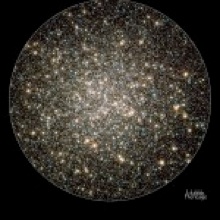Massive star clusters
across the Hubble time
ISSI International Team 271 led by C.Charbonnel (CH)
Massive star clusters
across the Hubble time
ISSI International Team 271 led by C.Charbonnel (CH)


Our understanding of globular clusters – massive stellar aggregates, relics from the early Universe – has been completely overthrown during the past years. Indeed, deep photometric surveys with the Hubble Space Telescope and unprecedented spectroscopic observations on 8-10m class telescopes have revealed the presence of multiple stellar populations displaying complex abundance patterns in these objects that were previously thought to be composed of coeval stars born with homogeneous composition. These recent findings, considered among the most spectacular results in stellar population studies in the past decade, have led to a complete paradigm shift in the field and to an important surge of activity on massive star clusters and related objects, young and old, in the local universe but also at high redshift. This opens new exciting perspectives for our understanding of star formation and of the initial stellar mass function in various environments. This also calls for major revisions of the current concepts regarding the role massive stellar clusters play in the assembly and evolution of galaxies across the Hubble time.
In this new paradigm, members of the Team have proposed a scenario in which fast-rotating massive stars play a key role in inducing the birth of multiple populations of stars in massive clusters and in shaping their chemical properties. The crucial steps we will tackle from the theoretical, numerical, and observational points of view in the present project are to quantify how stars of various types and masses contribute to the chemical enrichment of massive star clusters, to investigate how they pollute and shape the intracluster gas from which subsequent stellar generations may form, to understand the interplay between cluster dynamics and stellar evolution, and to explore the influence of the environment on interstellar medium physics and stellar formation over cosmic time. We will also revisit the initial mass function of stellar clusters, as well as their contribution to galactic haloes. We aim at explaining self-consistently all the observed features of multiple stellar populations in globular clusters in existing HST and VLT data, and we will set up new original observational programs.
To achieve these goals our ISSI Team gathers specialists working on stellar and interstellar matter magnetohydrodynamics, multi-dimensional numerical simulations, galactic chemical evolution, star and planet formation, spectroscopic analysis, and N-body simulations. Our developments will optimize the exploitation of large cutting-edge surveys with both ground-based telescopes and the ESA and NASA space missions GAIA, Herschel, and HST. They will prepare the ground for future observations with ALMA and later SKA and JWST that will open the possibility to resolve super star clusters and to study their relation to globular clusters, as well as with the next ESO multi-object spectroscopic facility being foreseen to become operational by 2018-19. The latter, especially, will represent the ideal machine to follow-up on the results of this project, being able to target hundreds of objects simultaneously in any given field, thus mapping chemically, kinematically, and dynamically globular clusters.
Summary
